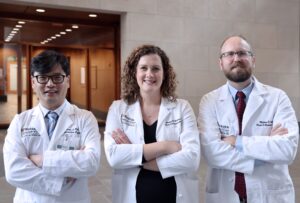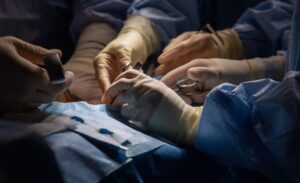Nerve Surgery
Nerve injuries and disorders range widely in their complexity, as do the treatments available to lessen pain and restore mobility. Injuries to the peripheral nerve system—nerves in the shoulders, arms and legs, for example—are common and can be caused by a variety of factors. Some nerve disorders can affect muscles and result in loss of sensation, paralysis and pain.
Overview
Many people who seek relief from a nerve disorder are in pain that can be debilitating, affecting every aspect of life. We work with these kinds of injuries with our pain management colleagues who are specifically trained to treat nerve injuries and disorders. We offer treatment that is tailored to each patient’s specific condition and performed by specialists who excel in technical expertise and compassionate care. Your surgeon will work to gain a thorough understanding of your condition and offer treatment options that can help alleviate pain and restore mobility.
Nerve Regeneration
After injury, a nerve will try to repair itself by sprouting in regenerating nerve units. These regenerating units will then try to restore function to any affected muscle or skin, a process called reinnervation. When these nerves make a correct connection, the body is able to recover muscle function and skin sensation, if lost, is likely to return. But if the regenerating nerve fibers do not make a correct connection, the injury does not heal.
Nerves regenerate at a rate of about one inch per month. Although it is possible to regain sensation after nerve supply depletion (called denervation), muscle reinnervation will not occur after long periods of time without nerve innervation (nerve supply). In other words, the more quickly an injured nerve is reconnected to muscle, the more likely it is that recovery will take place. Our specialists may use tests called electrodiagnostics (EDX) or electromyography (EMG) to test muscle recovery over a period of time. If the nerve-muscle connection doesn’t occur in three to six months following an injury, your specialist may discuss surgical treatment with you.
Nerve Surgery
If surgery is the best treatment option for you, you will likely have one of the following types of surgery: nerve repair, nerve graft, nerve transfer, neurolysis or tendon transfer. Again, your specialist will talk with you about the treatment best suited to your condition.
To foster nerve regeneration, nerve fibers need to be guided to the appropriate muscle or sensory unit. If the nerve has been cut, a nerve repair procedure is used to reattach the two ends of the nerve. This works best when the nerve has been cut sharply and cleanly. When there is more extensive injury and the nerve ends can’t be reconnected, a surgery called nerve graft may be a more suitable option.
In a nerve graft, a small piece of donor nerve is used to bridge the gap between the two nerve ends; the damaged nerve will then regenerate across the graft to provide recovery. The nerve graft, using small, non-critical sensor nerves, is taken from another part of the body. If the nerve injury gap is small, then a cadaver nerve may be used.
Nerve transfers are slightly different than nerve grafts. In severe injuries, recovery may not be anticipated for a very long period of time. Rather than grafting a nerve from another place on the body, nerve transfers make use of a nerve closer to the point of injury, allowing for more efficient recovery.
Sometimes scar tissue will form around the injured nerve and prevent it from regenerating. A procedure called neurolysis can remove scarring and thus encourage the nerve to heal properly.
Conditions & Treatments
Our nationally recognized surgeons are dedicated to focusing on your unique nerve surgery needs and the following conditions:
- Brachial plexus injuries
- Nerve injuries
- Carpal tunnel
- Cubital tunnel
- Radial, median, ulnar, femoral, peroneal and tibial nerve injuries
- Neurofibromatosis
- Cervical-level spinal cord injury
- Quadriplegia
- Tetraplegia
- Foot drop
- Complex regional pain syndrome
- Pain from neuromas or nerve injuries
- Other peripheral nerve disorders
- Thoracic outlet syndrome
- Brachial plexus
- Cumulative trauma disorder
- Facial palsy
- Melanoma and sarcoma nerve compression
- Phantom pain
- Neuroma pain
- Migraines
- Nerve repair
- Nerve graft
- Nerve transfer
- Neurolysis
Why Choose Us?
Our team of nerve-injury specialists are associated with The Washington University Center for Nerve Injury and Paralysis, which cares for people with nerve and peripheral nerve injuries and disorders. The Center was established by Susan Mackinnon, MD, the Center’s director, who performed the world’s first donor nerve transplant, a procedure that can repair nerves in limbs that previously were considered irreparable. She also popularized the field of nerve transfer surgery.
We offer what often are life-changing advanced surgical techniques, including grafting and nerve transfer procedures for severe nerve injuries. Our plastic and reconstructive surgeons work with neurosurgeons, neurologists and therapists to achieve the best results for the people who come to us for care.
What to Expect
Once you request an appointment, our scheduling team will call you to schedule your initial consultation with a nerve specialist.
Because our surgeons are trained and experienced in all aspects of nerve surgery, we can offer comprehensive treatments tailored to children and adults. If your condition requires surgical reconstruction, we will discuss with you the various options available, including their benefits and risks. And we will work with you to determine the treatment plan for your specific needs, ensuring that you understand the plan and can feel confident about the decisions you make.


